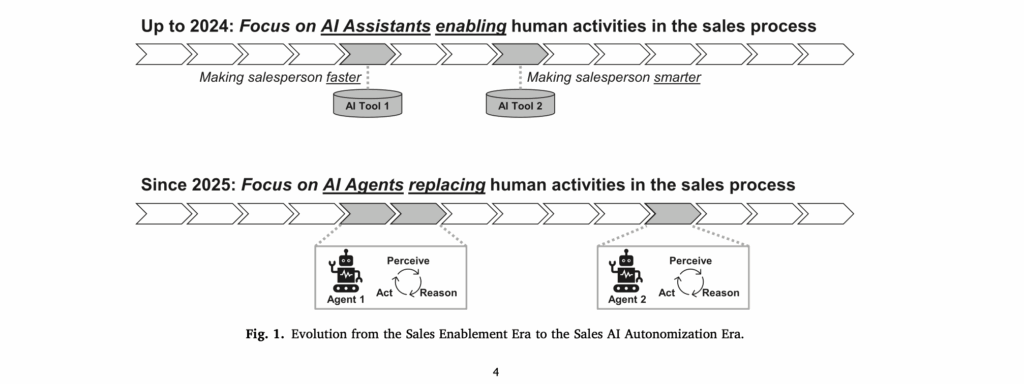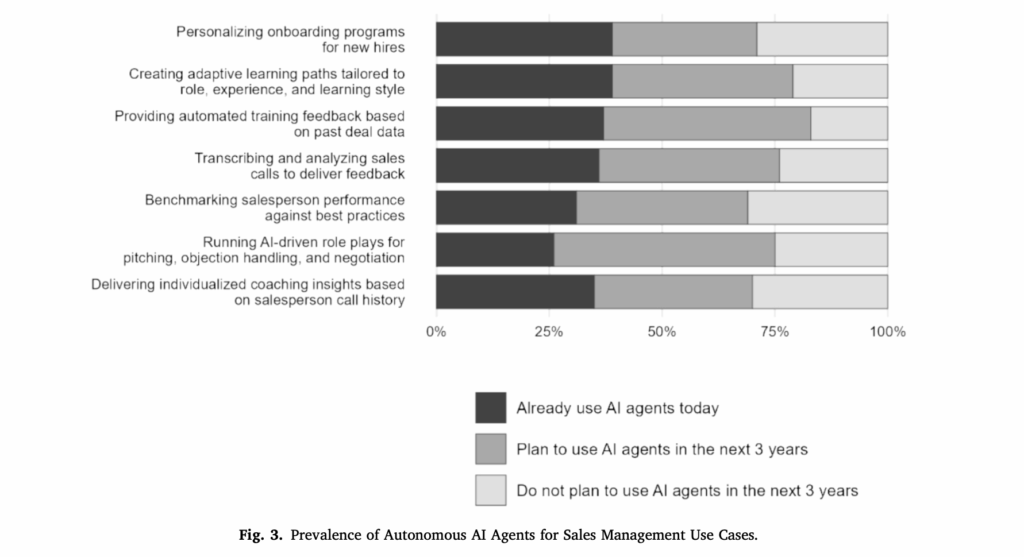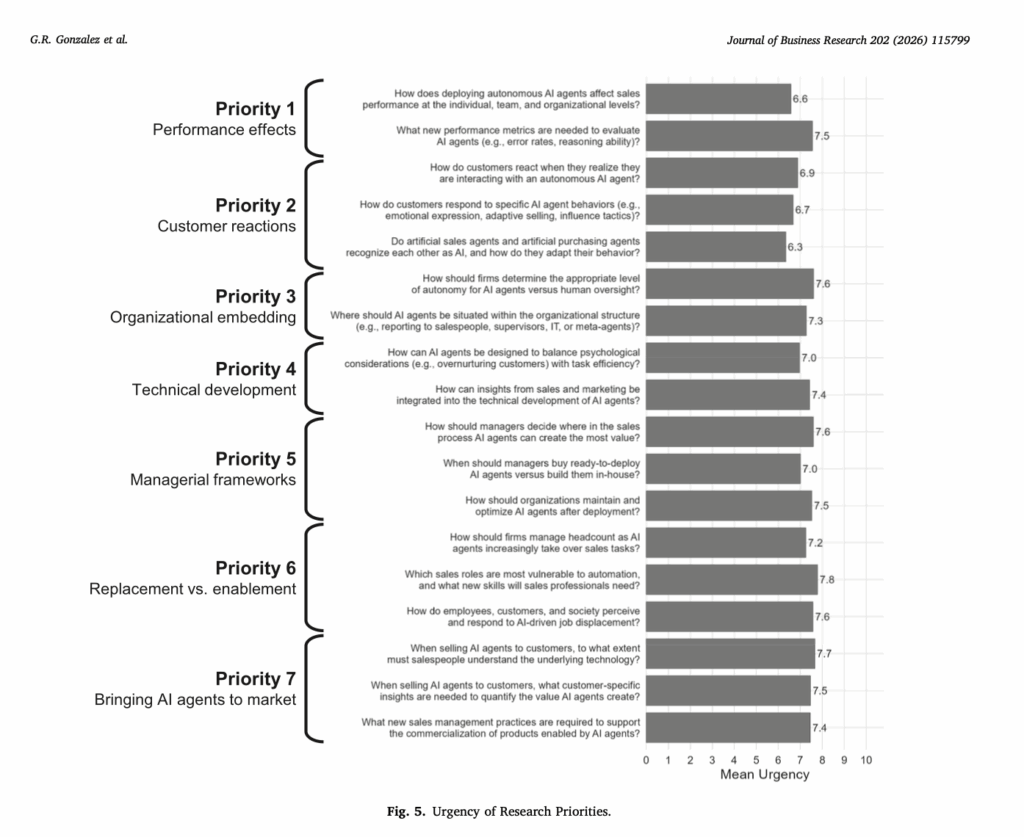Based on “AI Agents, Agentic AI, and the Future of Sales” by Gabriel R. Gonzalez (San Diego State University), Johannes Habel (University of Houston), and Gary K. Hunter (University of Mississippi), published in the Journal of Business Research (2026).
TL;DR
AI in sales is growing up. We started with assistants that helped humans; now we have agents that act like them. The challenge is whether companies can manage it wisely. That’s where education, certification, and leadership come in. Because the future of sales isn’t human or machine, it’s both, working together under a shared standard.
🌍 Welcome to the era of Agentic AI
Remember when “AI” in sales meant a chatbot that wrote emails a bit faster than you could? That was 2023. Today, we’re entering the Age of Agentic AI, where machines no longer just assist humans, but start to act on their own.
Gonzalez and colleagues call this shift the Sales AI Autonomization Era, the moment when AI stopped being a sidekick and became a team member.

From Sidekick to Co-Worker
The paper shows a simple but powerful diagram (Fig. 1):
- Up to 2024: AI Assistants made salespeople faster and smarter, automating repetitive work like data entry, CRM updates, or copywriting.
- Since 2025: AI Agents are replacing parts of the human workflow, they perceive, reason, and act without waiting for you to click “run.”
In short, the shift is from AI as a tool to AI as a collaborator.
These agents can:
- Read customer intent across emails and CRM notes.
- Draft offers and follow-ups.
- Schedule demos and adapt tone mid-conversation.
- Even negotiate within pre-set parameters.
🧪 How the study was done
This isn’t just theory. The authors:
- Reviewed dozens of scientific and industry sources on AI adoption in sales.
- Surveyed 100 sales leaders from diverse industries and company sizes.
- Asked about current and planned uses of autonomous AI agents, as well as the biggest open questions executives have about performance, customers, and ethics.
That combination of academic rigor plus industry reality makes the paper one of the clearest roadmaps for where AI-driven selling is heading.

What sales teams are actually using AI agents for
Here’s the fun part: we finally have data on what companies are doing.
Figure 3 in the paper maps how sales leaders are using (or planning to use) AI agents for management and coaching.
Top use cases include:
- Personalized onboarding for new hires (because no one reads the 80-page training manual anyway).
- Adaptive learning paths that adjust based on each rep’s experience.
- Automated coaching that gives feedback on real calls.
- AI-driven role-plays that simulate objections and negotiations.
- Performance benchmarking that compares reps against best practices.
Across all categories, more than half of sales teams already use or plan to use autonomous agents within the next 3 years. This means AI is training the sellers.

The seven big questions keeping executives awake
The authors asked sales leaders which research areas feel most urgent for the next three years. Here’s what they said — and why it matters:
| Priority | Focus | Why it Matters |
|---|---|---|
| 1. Performance effects (7.5/10) | How do we measure what “good” looks like for an AI agent? | Traditional metrics (speed, volume) don’t tell you if the AI’s reasoning is sound. |
| 2. Customer reactions (6.9/10) | How do buyers respond when they realize they’re talking to AI? | Trust and transparency can make or break adoption. |
| 3. Organizational embedding (7.6/10) | Where should AI agents “live” — under Sales, IT, or Operations? | No clear playbook yet. Culture matters as much as tech. |
| 4. Technical development (7.4/10) | How do we design agents that persuade ethically? | AI needs empathy and compliance. |
| 5. Managerial frameworks (7.6/10) | How do managers supervise agents without micromanaging them? | Leadership needs new dashboards — and new mindsets. |
| 6. Replacement vs Enablement (7.3/10) | Will AI shrink teams or expand capacity? | Most likely both. Roles will evolve, not vanish. |
| 7. Bringing AI to market (7.4/10) | How do you sell AI agents when even your client doesn’t fully understand them? | Education becomes part of the product. |
These seven priorities show that leaders are trying to design a sustainable human-machine partnership.
🧩 Key takeaways — for non-techies
- AI is learning to take initiative. We’ve moved from “Hey, can you help me write this email?” to “Hey, can you handle this lead?”
- Adoption is accelerating fast. Over 60 % of companies are already testing autonomous agents in some form.
- Metrics are changing. Instead of counting emails sent, we’ll measure reasoning quality, alignment with company values, and impact on trust.
- People still matter. Agents are great at doing, but humans are still better at feeling. Empathy, ethics, and creativity will stay core.
- Leaders need standards. The biggest risk isn’t rogue AI, it’s un-certified AI. Without frameworks, even good intentions can go wrong.
Certify your Company
At Silicon Valley Certification Hub (SVCH), we see this research as validation for what our certifications are designed to solve:
- Companies are adopting AI faster than they’re building governance.
- Executives need clear frameworks for strategy, oversight, and ethics.
- Teams need shared language — a way to prove competence and trust.
That’s exactly what the CAIO-CP™ and organizational certification programs do: help leaders move from experimentation to standardization, the same way safety standards once helped industrial automation scale responsibly.
Because the next competitive advantage is having AI you can trust.



0 Comments